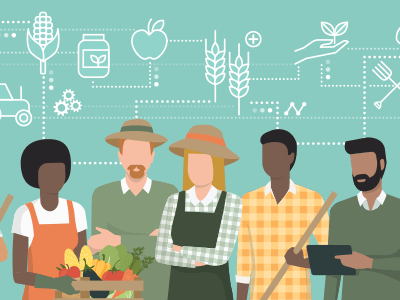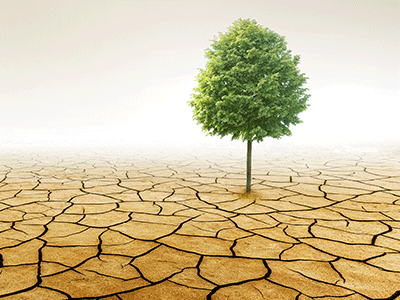What is the future of food and farming
What is the future of food and farming
Tambien disponible en español | Egalement disponible en français
How will the global food, agriculture and fisheries system evolve in coming decades? A lot will depend on government policies.
Demand will remain strong in the medium term, given current macroeconomic assumptions
The OECD-FAO Agricultural Outlook projects that demand for food, agriculture and fisheries products will continue to grow over the next decade. However, growth will be at a slower pace than in the recent past, when exceptionally strong growth in China and the largely policy-induced expansion of biofuels spurred demand. The main exception to this slowdown in demand growth is fresh dairy, as income and population growth in India are expected to lead to a strong increase in consumption. Despite slower growth, the additional demand for most commodities will still be considerable, with most of the extra demand coming from China, India, and Sub-Saharan Africa.
Food trade will increase and contribute to building global food security, assuming current policies
Because of differences in geography, climate and population density, some parts of the world are better suited to produce food, agriculture, and fisheries products than others. Over the past few decades, international trade between these regions has intensified. Countries in North and South America in particular have emerged as major agricultural exporters. At the same time, agricultural imports have increased in Sub-Saharan Africa, in the Middle East and North Africa, and in South and East Asia (most notably in China). These trends are expected to continue over the coming years, underscoring the growing importance of international trade for global food security.
Technological developments, and digitalisation in particular, are evolving rapidly
Across the globe, countries are in various stages of evolution from (primarily) physical economies, to service economies, to digital economies – and potentially to the “single economy”, where data are pervasive across all economic activities and society. Much international attention today is focused on how best to harness the enormous opportunities associated with digitilisation, while avoiding potential threats to specific jobs and to countries, regions, sectors, and individuals who may be unable to invest in, and benefit from, digitilisation.
The food, agriculture and fisheries sector will need to situate itself within this wider framework, to ensure coherence across policy fields domestically and to avoid policy fragmentation internationally. This will require a greater level of international co-operation than is evident today. In many countries, it will also require much greater investments, and public-private collaboration, in digital infrastructure and related education and training than is available today.
Of course, traditional research and development remains a priority and more could usefully be done by both the private and public sectors. Plant and animal breeding to enhance productivity and resilience to climatic events, development of less environmentally harmful plant protection chemicals, and improved fertilizers are amongst the priority areas for a more sustainable agriculture.
Productivity growth, sustainable resource use, and climate change require urgent attention
Global production of food, agriculture and fisheries is on track to meet rising global demand. The capacity of the sector to respond to even unexpected increases in demand remains strong, in both developed and developing regions of the world. The most recent spike in many commodity prices, in 2007-08, for example, sparked an immediate supply response that satisfied markets and replenished stocks quickly.
Countries can do more to shift some of the resources they dedicate to the sector to support research and development (to advance new technologies) and technology transfer and extension services (to increase adoption and appropriate of available technologies and best practises). The economic case for doing is clear, as the well documented returns to R&D are huge.
Countries can also do much more to open markets, allowing goods to flow more easily and predictably from where they are best produced on a sustainable basis to where they are consumed. While border restrictions matter, behind-the-border non-tariff measures (NTMs) are particularly important in the food, agriculture and fisheries sector. While NTMs often facilitate trade, poorly designed measures can sometimes impose unnecessary costs on traders, disadvantaging smaller producers in particular.
A key challenge is whether continued growth in production can be achieved sustainably. Agriculture has a considerable environmental footprint, as the largest user of the world’s land and water resources and an important source of greenhouse gas emissions. Fish stocks are under increasing pressure from overfishing, while aquaculture raises concerns about the degradation of ecosystems. Under current policy settings, the food, agriculture and fisheries sector can be expected to continue to under-perform with respect to sustainability, climate, and resilience goals expressed by governments.
A lot depends on policies
Governments have an opportunity to begin to roll back ineffective policies that are, in many cases, simply legacies of the past. In this way, scarce financial resources will be released that can be devoted to coherent policy packages that can contribute to a productive, sustainable, and resilient sector. The recipe will differ across countries, but the basic ingredients are largely the same.
- Remove existing policy dis-incentives to increasing productivity, sustainability and resilience. Reduce and eventually eliminate government support directly linked to output and input use. This would allow domestic and international markets to function better, discourage over-use of inputs that can damage the environment, and make limited public funds available for new investments that can enable increased productivity, sustainability and resilience.
- Re-direct food, agriculture and fisheries support to ensure the availability of public services that benefit producers, consumers and society overall. This can include effective human, animal and plant health systems, appropriate science-based biosecurity efforts, well-functioning agricultural innovation systems, and digital infrastructure, amongst others.
- Encourage collaboration on knowledge generation and transfer with public and private actors – nationally, regionally and internationally. Public investment in research, including efforts to ensure that the outputs of research reach farmers, can go a long way to ensure that the sector has the capacity to respond to evolving needs and challenges. New information and communication technologies also offer largely untapped potential to improve farm productivity, sustainability, and resilience.
- Draw on the full range of economic instruments, including information, education, regulation, payments and taxes, in pursuit of environmental and climate change goals. Where knowledge is inadequate, relevant data and indicators need to be developed. Better policies require a robust information base on environmental outcomes from alternative agricultural production practices and their links to policy incentives.
- Streamline risk management policies by clearly defining the limits between normal business risks, risks for which market solutions can be developed, and catastrophic risks requiring public engagement. Doing so enables pre-defined public intervention, when required, while sending clear signals to farmers and other private agents for developing market-based risk management tools. Governments can also play a proactive role in providing information on market risks and coping strategies for farmers and the private sector.
- Improve understanding of the financial and well-being situation of farm households to design effective farm-income support measures. Internally consistent data are often lacking on the income and wealth status of farm households, going beyond aggregates and averages to encompass the distribution of financial conditions across the full range of farm households, relative to non-farm households in any given country.
The implications of such a policy shift are significant. While consumers and society overall can be expected to benefit substantially, the burden of adjustment will fall more narrowly on relatively resource-poor farm households unable to adjust on their own. In some cases adjustment within in the sector will be possible, with time and transitionary support from governments; in other cases adjustment will require moving out of the sector to more remunerative employment opportunities. Well targeted temporary income support and active labor market measures will be required to support the needed adjustment, ensuring that no one is left behind.
How we feed the world today
The global food system continues to respond to the needs of a growing and more affluent world population. Learn how we got here.
What governments are doing
Government policies and interventions play a major role in shaping food and agriculture markets, but policies are not always well aligned to evolving objectives.
Opportunities and threats to food systems
Resource depletion and climate change pose major challenges to the global food system, but there are opportunities for policy to help address these challenges.


